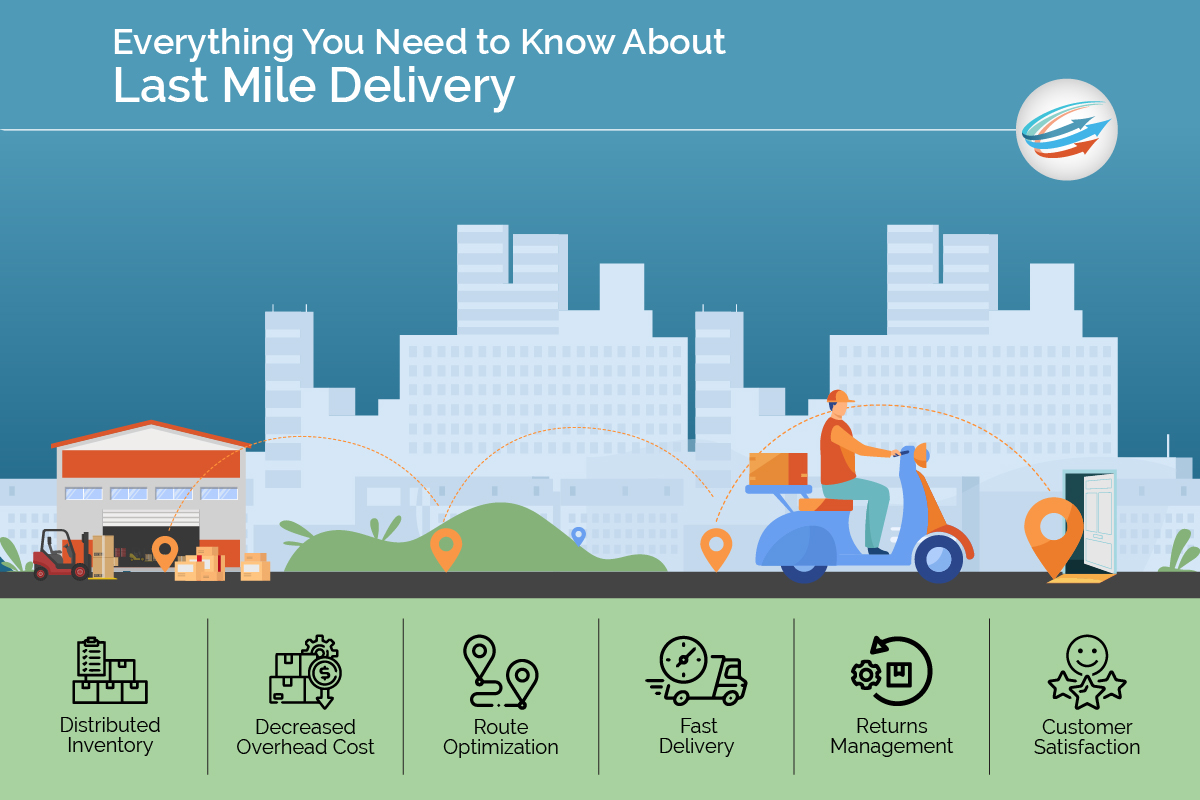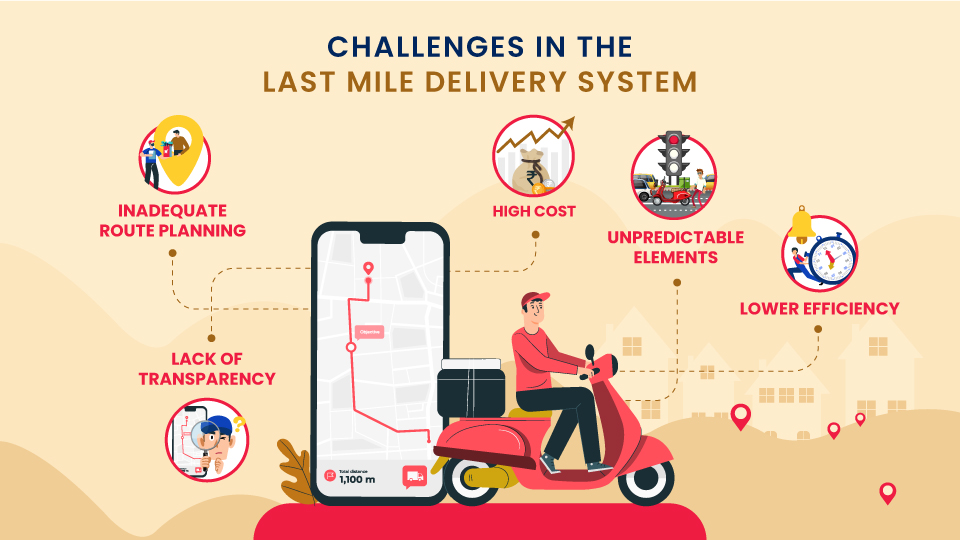What is Last Mile Delivery?
Last mile delivery refers to the final step of the delivery process — the point at which a parcel is moved from a transportation hub to its final destination. This step is critical, as it's the point of customer contact and greatly influences satisfaction.

Why is Last Mile Delivery Important?
The following reasons show the importance of Last Mile delivery.
Customer Satisfaction: A smooth last mile ensures customers receive their packages on time, directly affecting their satisfaction and loyalty.

Competitive Edge: Businesses that excel in efficient Last Mile delivery can outshine competitors by offering better service.
Cost Reduction: Optimizing the last section of delivery can significantly reduce shipping costs, which compose a large portion of the overall transportation costs.
The Challenges of Last Mile Delivery

The challenges of Last Mile Delivery are the following:
Urban Congestion: Delivering in densely populated areas often faces traffic delays, leading to late deliveries.
Rural Deliveries: Remote locations may be difficult to serve efficiently, increasing costs and delivery times.
Customer Availability: Coordinating delivery times with customers can be a logistic challenge.
Key Players in Last Mile Delivery

The key players of Last Mile Delivery are the following:
Carriers (Delivery Companies): Carriers are the backbone of last mile delivery, handling the logistics to get the package to the doorstep.
Warehouses & Fulfillment Centers: These facilities manage inventory, preparing orders for the last stage of delivery. Their efficiency directly impacts delivery speed.
Customers (Consumers & Businesses) :The end receivers of last mile delivery, whose expectations and demands drive innovations and improvements in the service.
Last Mile Delivery Terminology
The methods of Last Mile Delivery are the following:
Traditional Delivery Methods:The traditional Last Mile delivery methods are as follow:
Postal Services:Postal services are a cornerstone of last mile delivery, known for their wide network.
Couriers & Delivery Trucks:Offer personalized service with a higher cost but can accommodate special delivery needs.
Innovative Delivery Methods:The innovative Last Mile delivery methods are as follow:
Drone Delivery:Drones promise to speed up last mile delivery, especially in hard-to-reach areas, minimizing human effort and road congestion.
Self-Service Lockers & Pick-Up Points:These options offerbflexibility for customers to collect parcels at their convenience.
Autonomous Vehicles:Though in the nascent stages, they present a future where deliveries are done without human drivers, potentially lowering costs and increasing efficiency.
Optimizing Last Mile Delivery
Now it’s time to see the optimization of Last Mile Delivery.
Route Optimization & Planning: By optimizing routes, companies can ensure faster delivery times while reducing fuel consumption.
Delivery Window Management: Offering specific delivery windows can enhance customer satisfaction by making last mile delivery more predictable. Real-Time Tracking & Visibility
Last mile delivery tracking: enables customers to see their package's journey, increasing transparency and trust.
The Future of Last Mile Delivery
The future of Last Mile Delivery are the following:
Sustainability Initiatives (Electric Vehicles, Green Packaging):Adopting electric vehicles and sustainable packaging can reduce the environmental impact of last mile delivery.
Technological Advancements (AI, Automation):AI and Machine Learning can predict delivery windows more accurately and optimize routes. Automation in warehousing helps in faster sorting and loading, speeding up the last mile delivery.
The Rise of E-Commerce and Same-Day Delivery:E-commerce growth accelerates the demand for efficient last mile delivery. Whereas Same-day delivery is becoming a norm, pushing companies to innovate continuously.
Last Mile Delivery Terminology
Here are the key terminologies of Last Mile Delivery.
Common Last Mile Delivery Terms: Few of the common Last Mile Delivery terms are:
Third-Party Logistics (3PL):These companies handle the outsourcing of last mile delivery and other logistics services.
Customer Experience (CX):The overall experience a customer has with a brand, significantly impacted by last mile delivery.
First Attempt Delivery Rate (FADR): Measures the success rate of deliveries made on the first attempt, a crucial metric for last mile delivery companies.
Cost Per Mile (CPM): The cost incurred for each mile of delivery, a key factor in last mile delivery budgeting.
Understanding Delivery Options: Now, check out the delivery options terms:
Same-Day Delivery: An accelerated last mile delivery option, promising parcel delivery on the day of order.
Next-Day Delivery: Guarantees delivery by the day following the order, reflecting the efficiency of last mile delivery companies.
Standard Delivery: Typical last mile delivery method with a predefined timeline.
Contactless Delivery: A response to health concerns, minimizing physical interaction during parcel handover.
The Impact of Last Mile Delivery
The impacts of Last Mile Delivery are the following:
Customer Satisfaction and Convenience: Last mile delivery is the final touchpoint with the customer, where prompt and efficient service can cement loyalty.
Efficiency in the Supply Chain :Smooth last mile delivery operations streamline the entire supply chain, preventing bottlenecks.
Environmental Considerations: The choice of delivery methods and technologies can significantly affect the ecological footprint of last mile delivery.
Last Mile Delivery Around the World
Around the globe, Last Mile Delivery is as follows:
Regional Variations and Challenges:Different geographical areas present unique hurdles for last mile delivery, from urban density to sprawling rural regions.
The Future of Last Mile Delivery in Different Markets: Adapting to local needs and leveraging technology will shape the evolution of last mile delivery globally, aiming for speed, efficiency, and sustainability.
Frequently Asked Questions (FAQs)
What is last mile delivery vs first mile delivery?
First mile refers to transporting goods from the manufacturer to the warehouse, whereas the last mile involves getting the product from the depot to the customer.
Is last mile delivery profitable?
Profitability is challenging due to high costs, but efficient operations and scale can make Last Mile delivery profitable.
What is the failure rate of Last Mile delivery?
Failure rates vary but are estimated to be around 5-10%, influenced by address accuracy, delivery speed, and customer availability.
Why is last mile delivery so expensive?
Last Mile delivery is expensive due to individualized stops, traffic delays, and the personalized nature of direct-to-consumer delivery.
Who are the biggest companies in Last Mile delivery?
UPS, FedEx, and Amazon are giants in the Last Mile delivery sector, handling vast daily volumes of packages globally.
